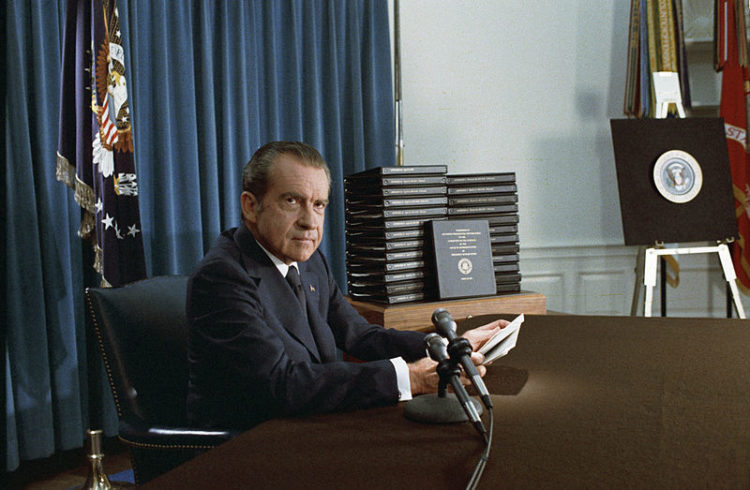Watergate, the scandal that predates Trump and Russia, on exhibit at IGS Library
Display of ephemera gives a taste of how Watergate played out at the time for many of those living through it in the early 1970s
January 29, 2019

Richard Nixon had Watergate in much the same way that Donald Trump has the Russia investigation. (White House photo)
For those of a certain age, Nixon and Watergate were and are linked together every bit as menacingly as Trump and Russia are today.
Watergate wasn’t the first scandal to envelop the White House, but it was the first to play out in almost real time for television audiences and newspaper readers.
Even then, the New York Times and the Washington Post were frenemies, each trying to outdo the other as the Watergate story morphed from the initial break-in at the Democratic Party’s sixth-floor offices in the Watergate complex in Washington, D.C., in June 1972 to hush money payments to the burglars to the ultimate revelation of a taping system in the White House that would let Americans hear the president neck deep in a coverup.
Reporters Bob Woodward and Carl Bernstein won a Pulitzer for the Post in 1973 for their coverage; Seymour Hersh, the lead Watergate reporter for the Times, had already won a Pulitzer in 1970 for unearthing the My Lai massacre in Vietnam.
The media helped drive the story that pushed Richard Nixon out of office. He resigned the presidency on Aug. 9, 1974.
Might Donald Trump suffer a similar fate? There’s no way to know. But it’s at least theoretically possible in this polarized age. And that makes current Watergate exhibit at UC Berkeley’s Institute of Governmental Studies all the more relevant. It’s not a huge exhibit, but it contains hints of the history of Watergate as it was happening, from books and pamphlets of the time to a copies of the Watergate tale as opined by the now defunct underground weekly the Berkeley Barb.
“It’s a story about issues like presidential overreach, executive privilege and lying to Congress, all of that,” exhibit co-curator Paul David King, circulation supervisor at the IGS Library, says. “We are anticipating interest from students possibly looking at those similarities. There are books that will be written about these similarities.

This is one of many views of Richard Nixon take by the Berkeley Barb during the days of Watergate. (Photo from the IGS Library collection)
“There is less understanding of Watergate from the undergrads. But the faculty and the general public definitely are well aware of it. We’re hoping that this exhibit can be an introduction to younger people as well.”
Another introduction comes tomorrow night (Jan. 30) when Charles Ferguson, who won an Academy Award for his 2010 documentary Inside Job about the 2007-2009 financial crisis, shows his newest film, Watergate, at Sibley Auditorium in the Bechtel Engineering Center at 6 p.m. The film premiered at Telluride in August. The campus showing is free, but attendees must register.
The showing, co-sponsored by the UC Berkeley Center for Latin American Studies and the Graduate School of Journalism, will be followed by a conversation with Ferguson led by Harley Shaiken, a professor of education and geography and CLAS director, and Maria Echaveste, the former Clinton White House deputy chief of staff and current director of policy and program development the Earl Warren Institute on Law and Social Policy at Berkeley Law.
“I think the history of this is so important right now,” exhibit co-curator Julie Lefevre, the digital services librarian at IGS, says. “One way to look at it is that Trump and Russia has its roots in the Nixon presidency. There all different ways to think about it. The kind of materials the IGS Library has, these kinds of ephemeral materials, those are the strength of our collection. And those are really the first draft of history.
“What we’re trying to highlight here are the clippings and the pamphlets and the underground news aspect of Watergate and how people were looking at it at the time. The is the time before the accepted narrative had been written.”
Founded in the middle of the Free Speech Movement in Berkeley, the Berkeley Barb had a 15-year run as an alternative newspaper. There was plenty in each issue about drugs, sex and what were then called alternative lifestyles, but the Barb also had a heavy political bent, complete with full-page cartoons, and Nixon was frequently the target.
The IGS Library, open Monday-Friday from 1-5 p.m. in Room 109 of Moses Hall, has an almost complete collection of the Barb, and it’s been mined for this exhibit.
“It’s a really rich resource to share with people,” King says. “We had to really cherry-pick images that we could scan; in fact, there is quite a bit more.”
The curators’ hope at some level is that viewers of the exhibit will question the standard Watergate narrative. They have published a library guide that was designed using the exhibit as a base but collecting Watergate materials from across the Berkeley campus as well as online resources.
“There are plenty of great books written about this crisis, this scandal,” King adds. “People now know about Deep Throat. But at the time it was looked at very differently.”
Coincidentally, this is the 100th anniversary of the founding of the IGS Library. The collection contains 400,000 items relating to politics and public policy covering the last century. There will be a series of events both on- and off-campus throughout the year.